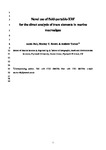Novel use of field-portable-XRF for the direct analysis of trace elements in marine macroalgae.
| dc.contributor.author | Bull, A | |
| dc.contributor.author | Brown, Murray | |
| dc.contributor.author | Turner, Andrew | |
| dc.date.accessioned | 2016-10-17T15:52:40Z | |
| dc.date.available | 2016-10-17T15:52:40Z | |
| dc.date.issued | 2017-01-01 | |
| dc.identifier.issn | 0269-7491 | |
| dc.identifier.issn | 1873-6424 | |
| dc.identifier.uri | http://hdl.handle.net/10026.1/6539 | |
| dc.description.abstract |
Samples of dried marine macroalgae (Fucus serratus, Palmaria palmata and Ulva lactuca) have been analysed for trace elements by a novel, non-destructive approach involving a Niton field-portable-X-ray fluorescence (FP-XRF) spectrometer configured in a low density plastics mode with thickness correction. Detection limits for a 200-s counting time ranged from <5 μg g(-1) for As and Pb in F. serratus and As in P. palmata to several tens of μg g(-1) for Cd, Sb and Sn in all species tested. Arsenic, Cu, Pb and Zn were detected by the XRF in samples collected from a protected beach (n = 18) and in samples therefrom that had been exposed to additional aqueous elements in combination (n = 72) with concentrations returned (in μg g(-1)) ranging from 3.9 to 39.7 for As, 13.0 to 307 for Cu, 6.1 to 14.7 for Pb and 12.5 to 522 for Zn. Independent measurements of trace elements in the macroalgae by ICP-MS following nitric acid digestion revealed a direct and significant proportionality with concentrations returned by the XRF, with slopes of the XRF-ICP relationships (As = 1.0; Cu = 2.3; Pb = 2.4; Zn = 1.7) that can be used to calibrate the instrument for direct measurements. The approach shows potential for the in situ monitoring of macroalgae in coastal regions that is currently being investigated. | |
| dc.format.extent | 228-233 | |
| dc.format.medium | Print-Electronic | |
| dc.language | en | |
| dc.language.iso | en | |
| dc.publisher | Elsevier BV | |
| dc.subject | Marine macroalgae | |
| dc.subject | FP-XRF | |
| dc.subject | Arsenic | |
| dc.subject | Copper | |
| dc.subject | Zinc | |
| dc.subject | Lead | |
| dc.title | Novel use of field-portable-XRF for the direct analysis of trace elements in marine macroalgae. | |
| dc.type | journal-article | |
| dc.type | Journal Article | |
| plymouth.author-url | https://www.webofscience.com/api/gateway?GWVersion=2&SrcApp=PARTNER_APP&SrcAuth=LinksAMR&KeyUT=WOS:000390736700025&DestLinkType=FullRecord&DestApp=ALL_WOS&UsrCustomerID=11bb513d99f797142bcfeffcc58ea008 | |
| plymouth.issue | Pt A | |
| plymouth.volume | 220 | |
| plymouth.publication-status | Published | |
| plymouth.journal | Environmental pollution (Barking, Essex : 1987) | |
| dc.identifier.doi | 10.1016/j.envpol.2016.09.049 | |
| plymouth.organisational-group | /Plymouth | |
| plymouth.organisational-group | /Plymouth/Faculty of Science and Engineering | |
| plymouth.organisational-group | /Plymouth/Faculty of Science and Engineering/School of Geography, Earth and Environmental Sciences | |
| plymouth.organisational-group | /Plymouth/REF 2021 Researchers by UoA | |
| plymouth.organisational-group | /Plymouth/REF 2021 Researchers by UoA/UoA06 Agriculture, Veterinary and Food Science | |
| plymouth.organisational-group | /Plymouth/REF 2021 Researchers by UoA/UoA07 Earth Systems and Environmental Sciences | |
| plymouth.organisational-group | /Plymouth/Research Groups | |
| plymouth.organisational-group | /Plymouth/Research Groups/BEACh | |
| plymouth.organisational-group | /Plymouth/Research Groups/Marine Institute | |
| plymouth.organisational-group | /Plymouth/Users by role | |
| plymouth.organisational-group | /Plymouth/Users by role/Academics | |
| dc.publisher.place | England | |
| dcterms.dateAccepted | 2016-09-15 | |
| dc.rights.embargodate | 2017-9-29 | |
| dc.identifier.eissn | 1873-6424 | |
| dc.rights.embargoperiod | 12 months | |
| rioxxterms.versionofrecord | 10.1016/j.envpol.2016.09.049 | |
| rioxxterms.licenseref.uri | http://www.rioxx.net/licenses/under-embargo-all-rights-reserved | |
| rioxxterms.licenseref.startdate | 2017-01-01 | |
| rioxxterms.type | Journal Article/Review |


